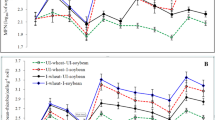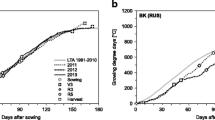Abstract
On fields with no history of soybean (Glycine max (L.) Merr.) production, inoculation alone is often inadequate to provide for adequate nodulation the first time this crop is grown. The objective of this study was to determine if inoculation of spring wheat (Triticum aestivum L.) seed with Bradyrhizobium japonicum would lead to an increase of B. japonicum numbers in the soil, and improve nodulation of a subsequent soybean crop. In the greenhouse, wheat seed inoculation increased B. japonicum numbers from undetectable numbers to >9000 g−1 of soil, whereas the numbers of introduced B. japonicum declined in unseeded pots. In the field, inoculation of wheat seed increased B. japonicum numbers in the soil from undetectable levels to >4000 g−1 the following year. When soybean seed was inoculated, but grown in soil devoid of B. japonicum, nodules formed only near the point of seed placement. The heaviest nodulation, and widest distribution of nodules in the topsoil were found whenB. japonicum was established the year before by wheat seed inoculation, plus soybean seed inoculation. Wheat seed inoculation the year before growing soybean, combined with proper soybean seed inoculation, should provide for abundant nodulation the first time soybean is grown on a field.
Similar content being viewed by others
References
Beard L 2000 North Dakota Agricultural Statistics 2000. Ag Statistics Bulletin 69, North Dakota Agricultural Statistics Service, Fargo, ND.
Brockwell J 1963 Accuracy of a plant-infection technique for counting populations of Rhizobium trifolii. Appl. Microbiol. 11: 377–383.
Diatloff A 1969 The introduction of Rhizobium japonicum to soil by seed inoculation of non-host legumes and cereals. Aust. J. Exp. Agric. Anim. Husb. 9: 357–360.
Domit L A, Costa J A, Vidor C and Pereira J S 1990 Inoculation of cereal seeds with Bradyrhizobium japonicum and its effect on soybeans grown in succession. Rev. Brasileira Ci. Solo 14: 313–319.
Hesterman O B and Isleib T G 1991 Response of first-year soybeans to row spacing, inoculation treatments, and nitrogen fertilization. J. Prod. Agric. 4: 589–593.
Kavimandan S K 1985 Root nodule bacteria to improve yield of wheat. Plant Soil 86: 141–144.
Kavimandan S K 1986 Influence of Rhizobial inoculation on yield of wheat (Triticum aestivum L.). Plant Soil 95: 141–144.
Lamb J A, Rehm G W, Severson R K and Cymbaluk T E 1990 Impact of inoculation and use of fertilizer nitrogen on soybean production where growing seasons are short. J. Prod. Agric. 3: 241–245.
Peres J R R, Suhet A R and Vargas M A T 1989 The establishment of Bradyrhizobium japonicum in Cerado soil by inoculation of rice seeds. Rev. Brasileira Ci. Solo 13: 35–39.
Weaver R W and Frederick L R 1982 Rhizobium. In Methods of Soil Analysis. Part 2. Chemical and Microbiological Properties, 2nd edn. Eds. A L Page, R H Miller and D R Keeney. American Society of Agronomy, Madison, WI, USA.
Author information
Authors and Affiliations
Rights and permissions
About this article
Cite this article
Goos, R.J., Johnson, B.E. & Carr, P.M. Establishment of Bradyrhizobium japonicum for soybean by inoculation of a preceding wheat crop. Plant and Soil 235, 127–133 (2001). https://doi.org/10.1023/A:1011999230635
Issue Date:
DOI: https://doi.org/10.1023/A:1011999230635




